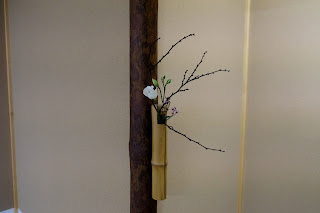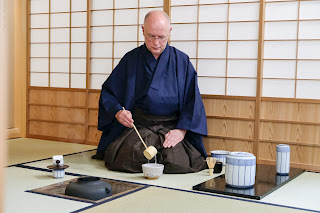Well, not really!
This provoking name stands for the Museum of National Art of Romania. But stepping inside, in the belly of the former Royal Palace, gives you the chills of an incredibly touching experience. The sober, glorious and majestic display of confused monumentalism, (trimmed here and there by the presence of ginkgo leaves design metal lacing cage style elevators, silently moving you from a surreal space to another, as you submit slowly to the acceptance of being lost forever), suddenly changes its face, as it spits you inside another universe: a quiet, dust free, temperature controlled white space, a drop of the "impossible" inside of the "possible".
There, on its own, sleeping like a cat, a little Japanese tea house, a Chashitsu with its friend, Roji, the tea garden. The first such construction to ever exist in Romania, grace to an auspicious encounter between the management of the museum, the Japanese Embassy in Romania, a group of remarkably generous sponsors and the talented hands and vision of the Japanese architects and builders.
Never had such a thing been so close to the Romanian public, hands able to feel the texture of the impeccably processed high quality wood, the eyes absorbing the transparency and fragility of the Japanese Shoji paper, the air filled with the smell of freshly washed straws of the tatami. A strange thing, reminding us of the Japan of the XVI century and the birth of the most incredible tradition ever, the Japanese Tea Ceremony. What to do?
What to do? Well, try it out.
We, the Chado Urasenke Tankokai Romania - Luminis Association, had the chance, thanks to the kindness of the museum management and in particular the museum director, Mr. Liviu Constantinescu and Carmen Brad, art historian and the curator of the tea room, to offer a demonstration of a Chaji, (a gathering of tea connoisseurs), for the museum staff who worked with abnegation and joy helping to bring alive this incredible construction - the Chashitsu.
Below, no talk, just images to let you share a bit of our emotions during this brief demonstration. The photos are the results of the presence of the mind and the hand of Andrei Nicolas Stefan, whom I met by pure chance, well in fact by being impressed by his work, who accepted to record this event and whom I strongly suggest you should follow, if you want to be delighted by what we, many times, are ignoring: the beauty of lights, shadows, the eye catching relevance of the detail lost in the sea of the routine and the presence of the human spirit.












No comments:
Post a Comment